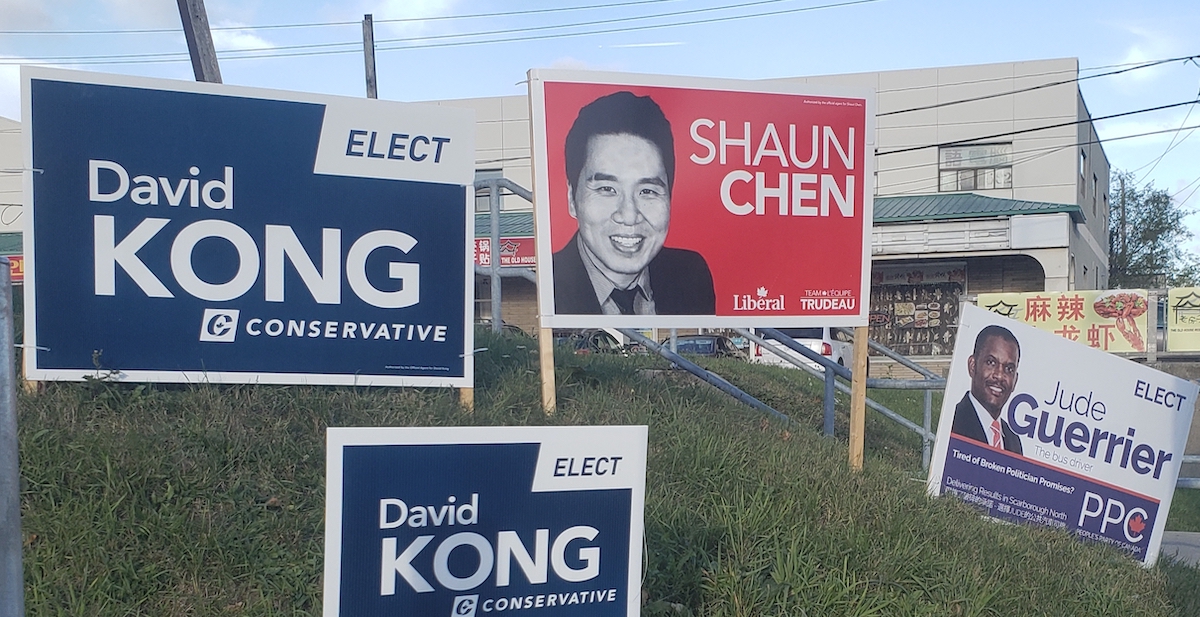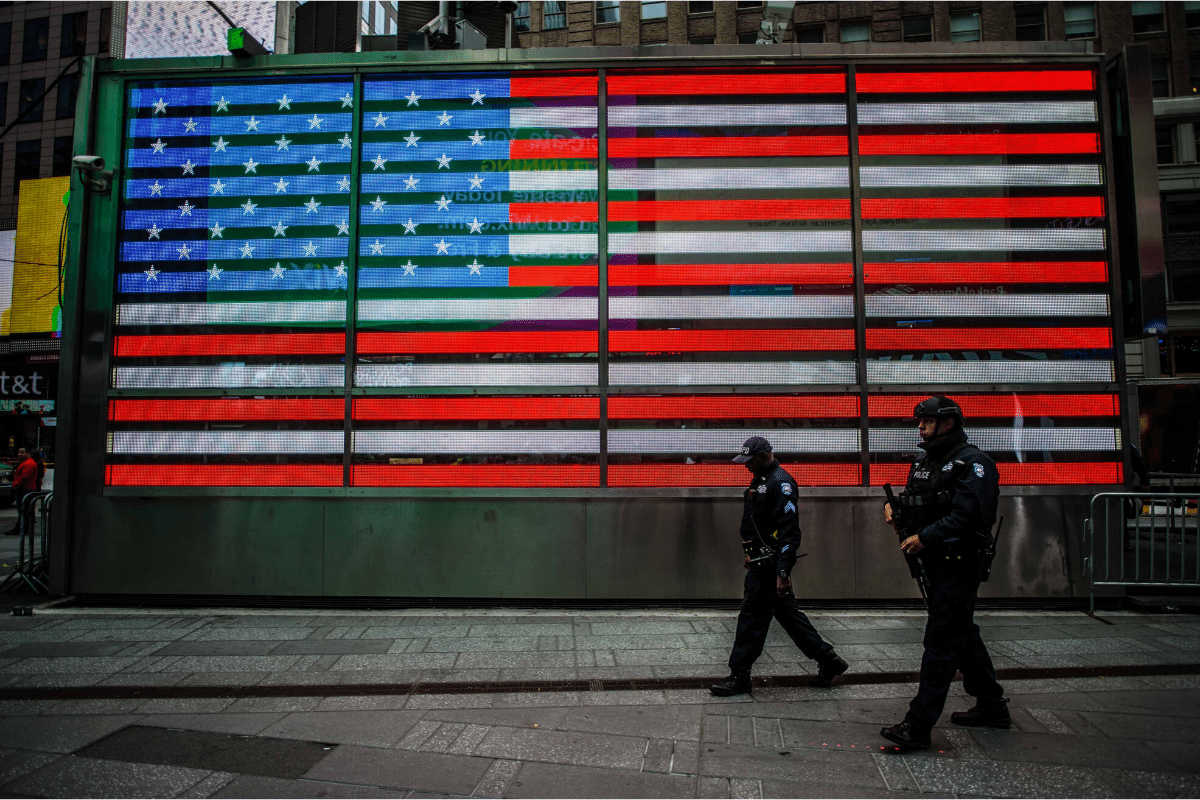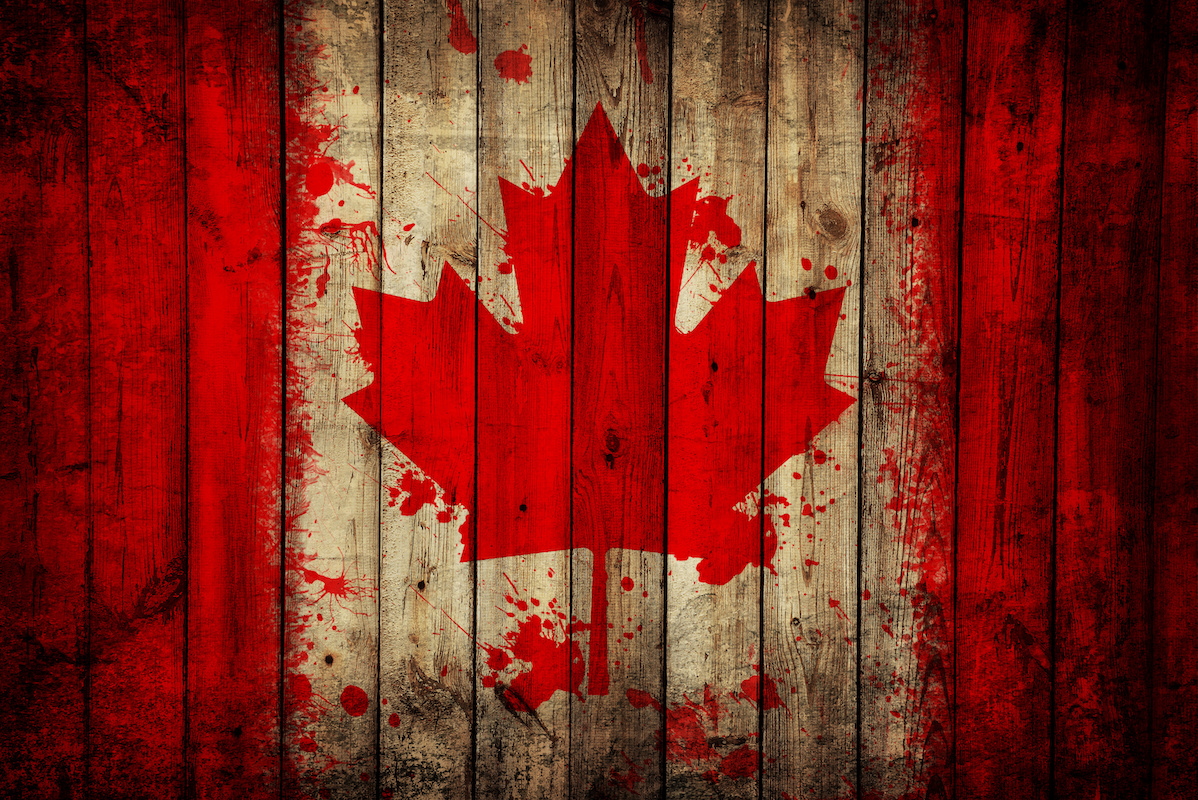Canada
Are Canadians Becoming More Racist? This Week's Election Proved the Opposite
Even if one accepts the Star’s generous tally of right-wing protestors at the pictured event—“about 15 people”—the conceit that “hate fills Edmonton’s streets” is ludicrous.

“Citizens ‘don’t feel safe’ as hate fills Edmonton’s streets,” proclaimed the Toronto Star on April 20, in reference to a gathering of Albertan white supremacists—one of at least two that occurred that month. In the lead paragraph, Star reporter Omar Mosleh grimly noted the ironic nature of a venue, Edmonton’s Churchill Square, “a place named after a world leader instrumental in defeating the Nazis.” The article was widely shared on progressive social media, where tales of Canada’s supposed slide into neo-Nazi extremism are now common currency.
But for anyone who looked past the headline, a mere glance at the accompanying photo showed the underwhelming totality of Edmonton’s allegedly epic hate-fest: about a dozen random locals, surrounded by a larger number of counter-protestors and curious onlookers, plus a sizeable detachment of police officers keeping order. Even if one accepts the Star’s generous tally of right-wing protestors at the pictured event—“about 15 people”—the conceit that “hate fills Edmonton’s streets” is ludicrous. There aren’t enough haters here to fill a parking spot.
The fact that such an article could appear in Canada’s biggest newspaper helps explain the hysterical tone suffusing our just-concluded federal election campaign, in which Justin Trudeau’s incumbent Liberals lost the popular vote to the opposition Conservatives, and got knocked down to minority Parliamentary status. As I wrote recently in Foreign Policy magazine, many of the big substantive issues that traditionally have divided Canadians—separatism, free trade, inter-provincial payments—weren’t on the table during this election cycle. And so much of the campaign discourse devolved into vacuous fearmongering.
The Liberals, in particular, fell back on the ludicrous claim that a Conservative government would roll back abortion and gay marriage while making common cause with fringe racists. In what arguably constitutes the absolute low point of the campaign, an advisor to Trudeau offered a widely panned Tweet suggesting that a photo of Conservative leader Andrew Scheer shaking hands with an outdoor worker wearing standard reflective work attire was a dog whistle to racists. How easy it was for Liberal supporters to forget that, just weeks earlier, it had been Trudeau, not Scheer, who was seen on a 1990s-era rafting video decked out in blackface, playing the part of Jim the slave in an apparent re-enactment of Adventures of Huckleberry Finn. (This marked at least the third documented instance of Trudeau in blackface, though the Prime Minister himself says he simply cannot remember how many times he has done this.)
Sad to see what’s happened to the once great Liberal Party.
— Jason Kenney 🇨🇦🇺🇦🇮🇱 (@jkenney) October 14, 2019
Justin Trudeau’s top advisor thinks a working guy wearing a mandated safety vest is a Nazi dog whistle.
A world away from Jean Chrétien praising the dignity of work. https://t.co/8DAJ4vsUYJ
Trudeau came to power in 2015 as a unifying left-centrist. During the first half of his mandate, he applied an admirably steady hand while guiding Canada through a potentially catastrophic trade crisis with the United States, and most observers (including me) had him as a shoe-in for easy re-election. But as the months passed, Trudeau and his advisors became seduced by the culture wars, and their postures on such issues as “toxic masculinity” and gender expression became increasingly indistinguishable from those of campus activists.
This in turn opened Trudeau up to charges of hypocrisy when his political moves—being governed, as with all politicians, by the art of the possible—were judged according to the unforgiving, absolutist standards of the social-justice puritanism he was now preaching. Trudeau sang from the environmentalist hymn book, but spent US$4-billion on an oil pipeline (earning him a rebuke from Greta Thunberg). He promised to bring about “reconciliation” with Indigenous people, but then fired his Indigenous Justice Minister when she (rightly) blocked his plans to coddle a politically influential engineering firm facing criminal charges. He made a spectacle of himself as a (literally) dancing mascot of multiculturalism, but mostly stared at his shoes when asked about provincial legislation that would ban Quebec civil-service workers from wearing visible religious attire.
Throughout it all, the main tactic that Liberals had to deflect negative attention was to insist that the greater threat to tolerant Canadian values lay with the Conservatives. (In one preposterous gambit, Trudeau’s immigration minister even cited the issue of Trudeau’s blackface to attack Scheer, affecting indignation that “the Conservative leader would bring up blackface to kick off a national debate without acknowledging real issues of systemic racism in Canada.”) And in this project, Trudeau found a willing ally in a national (and international) media corps that, having spent the last three years reporting on the genuinely racist pronouncements of U.S. President Donald Trump, was searching the political skies for signs that Trumpian xenophobia was metastasizing north of the border.
From a partisan perspective, yesterday’s election result seemed to disappoint almost everyone. The Liberals were knocked down to a minority. The Conservatives lost their shot at governing, despite facing a weakened, scandal-plagued PM. The left-of-Liberal New Democratic Party (NDP) and Greens both failed to make the quantum leap that some polls had predicted. Only the Bloc Québécois (BQ), a regional separatist party once given up for dead, had reason to pop a champagne bottle or two.

But the big story, for anyone who took seriously the pre-election social panic over allegedly epidemic levels of Canadian hate and bigotry, was that the only well-known party that offered anything close to an anti-immigrant agenda, Maxime Bernier’s People’s Party, got just 2% of the vote. Canada’s per-capita immigration rate is among the highest in the developed world, and 98% of voters supported parties which pledged to keep it that way.
Given that Canada is ranked as the world’s fourth most accepting country for immigrants, this should not be surprising to objective observers who live outside Canada’s progressive media bubble. (The global rankings have us just below Iceland, New Zealand and, oddly, Rwanda.) None of the major political parties said they would upset the status quo, by which Canada immigrates about 0.7% of its population every year. (The BQ’s critique of immigration policy was based on questions of regional allocation and French-language skills, not total numbers). Even Bernier’s more nativist PPC—dismissed as a fringe party by many—pledged to admit 150,000 immigrants per year, half of the current total, but still a level that would rank Canada respectably among OECD countries on per-capita intake.
Any Canadian who supported a truly xenophobic approach to immigration would have had to cast their vote for an even more obscure party, such as Christian Heritage Party or the Canadian Nationalists, which, taken together, attracted fewer than 20,000 of the 17.9-million total votes cast—or about one vote per thousand.
A few years back, when Trump was freshly elected and Trudeau still had his woke-warrior sheen, numerous pundits gushed about the lessons in tolerance that Canada supposedly had on offer for the rest of the world. But for the most part, it comes down to the accident of geography: Since Canada is physically isolated from large-scale land-based migrations, we aren’t beset by the uncontrolled flows that have sparked xenophobic ire in the United States and Europe. Moreover, as Jonathan Tepperman documented in his 2016 book The Fix: How Nations Survive and Thrive in a World in Decline, our system of selecting immigrants “primarily on the basis of what they could contribute to the Canadian economy—instead of what they looked like or whether they already had family in the country—[has yielded] impressive material dividends that benefited everyone.”

But this good news often is hidden: We have all been conditioned by U.S. and European media to identify immigration as a defining cleft issue between left and right. And so the lack of any real anti-immigrant constituency in Canada has created a sense of cognitive dissonance. Even after an election in which the People’s Party won exactly zero seats, a Globe & Mail columnist now warns us that the results should not be taken as “a definitive repudiation of right-wing populism,” since Bernier “was so bad at actually trying to advance that cause (an odd claim to make given Bernier’s surprise inclusion in the most widely watched debate).
Of course, Canada is a country of more than 37-million people. So it’s bound to have a few bigots—some of whom made cameo appearances during this campaign. This included yokels who made racist comments to NDP leader Jagmeet Singh, a turbaned Sikh. But even this became a good-news story, as Singh’s lucid and humane response to these scattered episodes went viral, and became a powerful earned-media signal booster for his own political brand. (Indeed, there are now enough of these videos online that they arguably constitute a new social-media genre that might be dubbed Canadian Tolerance Porn.) And when a Syrian restaurant in Toronto closed down “permanently” due to racist threats arising from a confrontation at a political event, the Liberals made a point of serving the restaurant’s food to its journalistic retinue. As of last reports, the restaurant is now back in business.
Perhaps the most powerful rebuke to fearmongering is the array of faces featured on the election signs now being picked up from lawns all over Canada. All of the major parties featured a wide diversity of candidates—including the conservative parties. In the Toronto riding of Scarborough North, where my daughter plays hockey, for instance, the race included (a) Shaun Chen, the son of Hakka Chinese immigrants, (b) Yan Chen, a Chinese-Canadian legal advocate, (c) Jude Guerrier, an immigrant from Haiti, (d) David Kong, a Chinese-Canadian immigrant and radio commentator, and (e) Avery Velez, a self-described “non-binary trans, queer, indigenous, activist, feminist, and Newfoundlander.” Can you guess which one of these candidates ran for Bernier’s PPC? (The correct answer may be found here.)
If a @peoplespca Candidate @tara_dos (former refugee from Zimbabwe) is labelled as ‘Nazi-Scum” in Canadian politics then we should be worried by growing intolerance of extreme left in our political arena https://t.co/7HKHEiv63h
— Tahir Aslam Gora ताहिर गोरा طاہر گورا (@TahirGora) October 18, 2019
But my favourite example comes courtesy of the PPC candidate in my riding, whose campaign signs were spray-painted “Fuck Off Nazi Scum” by Antifa supporters. Just a few years ago, one might imagine that the presence of such graffiti really might signal a political candidate with genuinely fascistic tendencies. But in 2019, we know better. The PPC candidate in question, Tara Dos Remedios, is a Sri Lankan-born woman who arrived in Canada as a refugee. If this woman of colour is what passes for a “Nazi” in 2019, then Canada is surely one of the luckiest nations on the planet.
Correction: This article was corrected on October 29, 2019, to clarify that Toronto Star reporter Omar Mosleh’s April 20 article contained information relating to two separate Edmonton rallies that occurred in April, 2019. The uncorrected version of this article incorrectly indicated that a photo taken at one event had been taken at the other.






